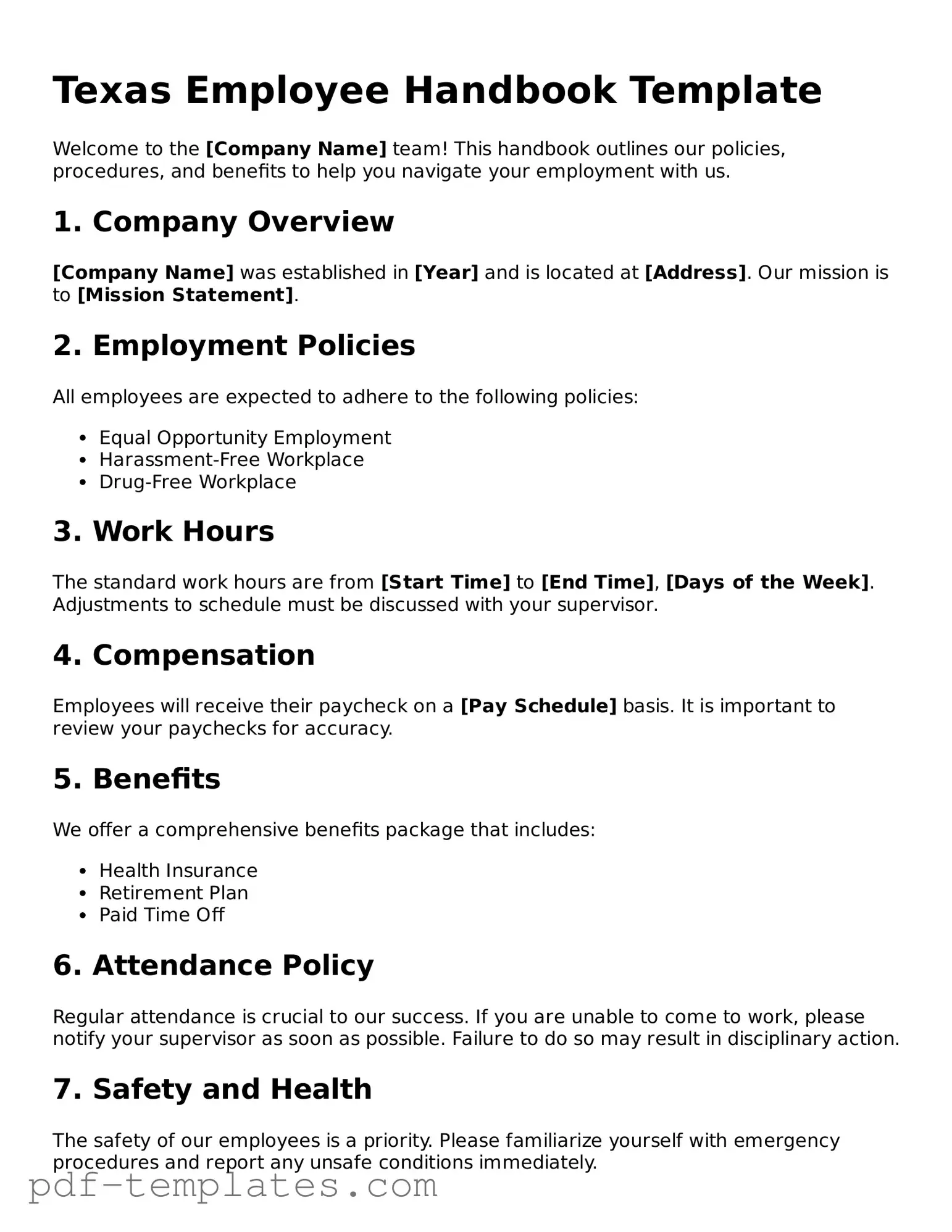The Texas Employee Handbook form shares similarities with the Employee Manual. Both documents outline workplace policies, procedures, and expectations for employees. They serve as a comprehensive guide that informs employees about their rights, responsibilities, and the company's operational guidelines. This manual is often used to reinforce company culture and ensure that all staff members are aware of the rules and benefits available to them.
Another document comparable to the Texas Employee Handbook is the Workplace Policy Guide. This guide focuses specifically on policies regarding workplace behavior, attendance, and dress code. It provides detailed instructions on how employees should conduct themselves while at work, ensuring a consistent and professional environment. Like the Employee Handbook, it aims to promote a positive workplace culture and minimize misunderstandings.
The Code of Conduct is also similar to the Texas Employee Handbook. It outlines the ethical standards and expectations for employee behavior. This document emphasizes integrity, respect, and accountability, ensuring that all employees understand the importance of maintaining a professional demeanor. Both documents serve to protect the company’s interests while fostering a respectful workplace.
The Orientation Manual often parallels the Texas Employee Handbook, particularly for new hires. This manual provides an overview of the company’s mission, values, and operational procedures. It is designed to help new employees acclimate to their roles and understand the broader context of the organization. While the Employee Handbook serves as a long-term reference, the Orientation Manual focuses on initial onboarding.
The Employee Benefits Guide is another document that complements the Texas Employee Handbook. This guide details the various benefits available to employees, such as health insurance, retirement plans, and paid time off. It ensures that employees are fully informed about their entitlements and how to access them. While the Employee Handbook may touch on benefits, this guide provides a more in-depth look at specific offerings.
The Safety Manual is similar in that it outlines the safety policies and procedures within the workplace. This document is crucial for ensuring that employees understand the importance of maintaining a safe work environment. It includes emergency procedures, reporting protocols, and safety training requirements. Like the Employee Handbook, it aims to protect employees and reduce the risk of accidents or injuries.
Understanding the various documents that define workplace policies is essential for fostering a knowledgeable and compliant workforce. Among these documents, the California Resale Certificate plays a vital role; businesses can utilize this form to make tax-exempt purchases meant for resale. For more information on this certificate and how it can benefit your business, visit formcalifornia.com/.
The Employee Performance Review Guide also shares characteristics with the Texas Employee Handbook. This guide outlines the process for evaluating employee performance, including criteria for assessments and feedback mechanisms. It serves to clarify expectations and foster professional development. Both documents emphasize the importance of communication and growth within the workplace.
The Harassment Policy document is another relevant comparison. It specifically addresses issues of workplace harassment and discrimination. This policy outlines the company’s stance on these matters and provides a clear process for reporting incidents. Similar to the Employee Handbook, it aims to create a safe and respectful environment for all employees.
The Leave of Absence Policy is akin to the Texas Employee Handbook in that it details the procedures and eligibility for taking leave from work. This document clarifies the types of leave available, such as medical or family leave, and the steps employees must take to request time off. Both documents ensure that employees understand their rights regarding time away from work.
Lastly, the Employee Exit Policy bears resemblance to the Texas Employee Handbook. This document outlines the procedures for employees who are leaving the company, whether voluntarily or involuntarily. It addresses topics such as final paychecks, return of company property, and exit interviews. Like the Employee Handbook, it aims to ensure a smooth transition for both the employee and the organization.
